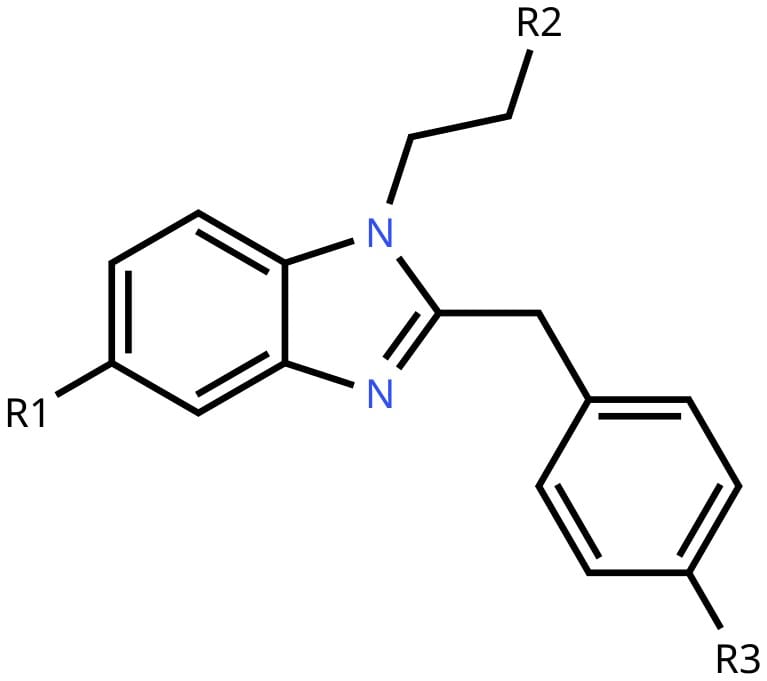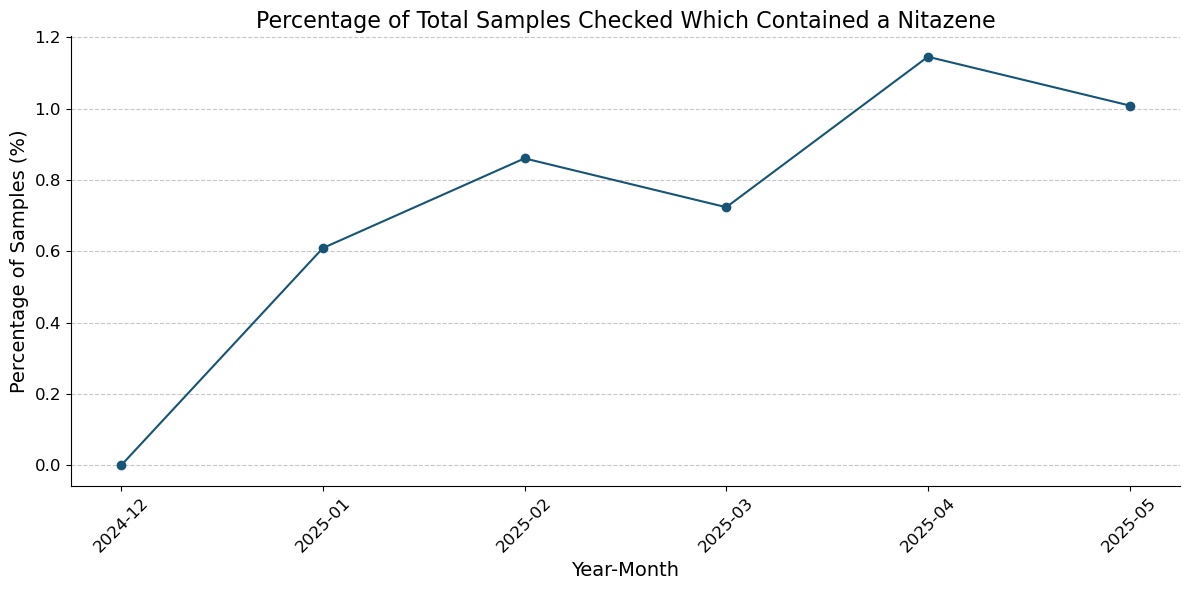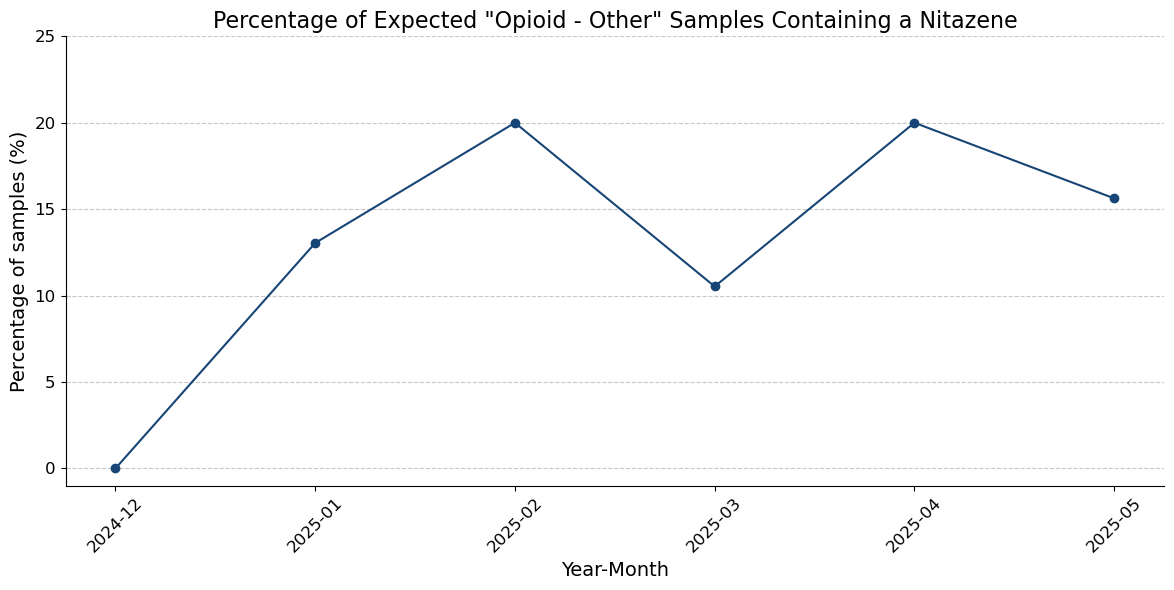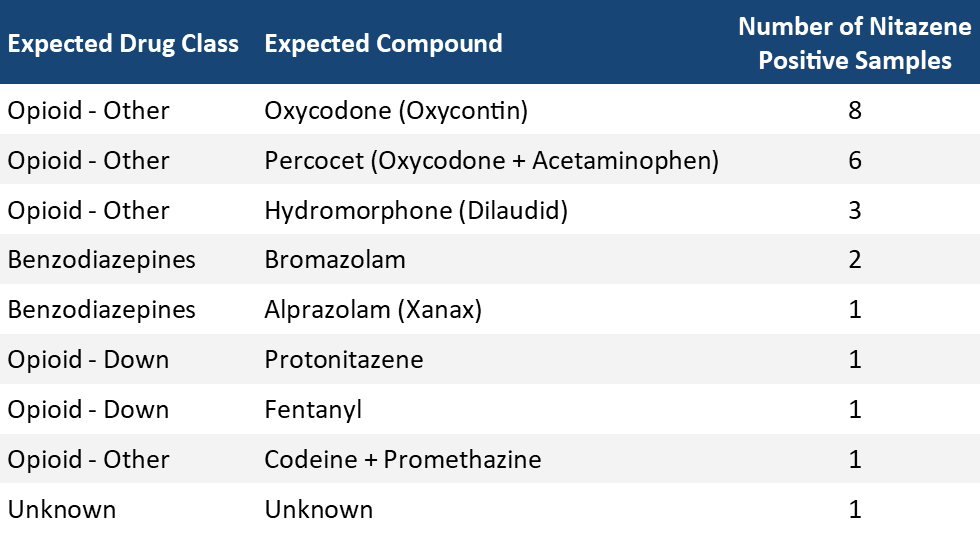Nitazenes: Novel Non-Fentanyl Synthetic Opioids in Today’s Drug Supply

Introduction
Nitazenes, also known as benzimidazole-opioids, are a group of synthetic opioids that have become increasingly relevant in recent years. First synthesized in the late 1950s by the Swiss chemical company CIBA Aktiengesellschaft, these novel non-fentanyl synthetic opioids were originally developed as potential pain medications but never approved for clinical use [1]. Today, nitazenes are being detected in the unregulated global drug supply, including Canada.
What Are Nitazenes?
Nitazenes are potent synthetic opioids that can vary significantly in strength. Some, such as isotonitazene and protonitazene, have been found to be 5-8 times more potent than fentanyl [2, 3], while others, such as butonitazene, are thought to be weaker than fentanyl [2].
Nitazenes in the Vancouver Island Drug Supply
In the past six months (December 2024 - May 2025), we have detected nitazenes in 24 samples, most commonly appearing as opioid-containing pills such as Oxycodone. The total proportion of samples containing nitazenes has risen steadily since December (Figure 1.) Prior to December 2024, nitazenes were detected, however, their detection was more sporadic. Approximately 16% of samples submitted as opioid press pills have been found to contain a nitazene compound; roughly 1 in 6 samples.

Since December 2024, we have detected nitazenes in counterfeit pressed pills expected to be Oxycodone (8 samples), Percocet (6 samples), and Hydromorphone (3 samples). In the past six months, "Opioid - Other" samples containing a nitazene account for 10 - 20% of all "Opioid - Other" samples (Figure 2).


Key Considerations with Nitazenes
1. Potency and Overdose Risk
The strength of nitazenes can make dosing unpredictable. Even experienced opioid users may not anticipate the effects, especially since the amount of active substance can vary widely between batches or individual pills [2]. As with other opioids, there is a risk of overdose, particularly if combined with other substances that suppress breathing or heart rate [2].
Likewise, the presence of nitazenes in counterfeit prescription pills raises particular concerns due to a growing number of youth who report using prescription opioids for non-recommended purposes [4]. This population may be at an increased risk for adverse effects if they do not already have a strong opioid tolerance and are unaware of nitazene pharmacology. Someone expecting to take a prescription preparation of oxycodone and acetaminophen (Percocet) may instead unknowingly ingest an opioid of a significantly higher potency than fentanyl.
2. Challenges in Detection
Standard fentanyl test strips do not detect nitazenes due to their different chemical structure [5], and most point-of-care drug checking requires specialized equipment to identify them [3]. Nitazene immunoassay test strips are available, however, they are limited in the amount of nitazenes they can detect, as well as in terms of accessibility and costs. Currently, the BTNX nitazene test strips have specificity only for isotonitazene, protonitazene, and N-pyrrolidino etonitazene. While it is common for immunoassay strip tests to detect a wide variety of substance analogues, a finite list of these compounds does not currently exist. Risk may be compounded when a negative fentanyl strip test is taken to represent that a pill which does not contain fentanyl is “safe” to consume or of “ true pharmaceutical formulation”. Visual identification of counterfeit press pills is not always possible as very realistic counterfeit pharmaceuticals are generated by modern clandestine manufacturers. Drug checking by any means available remains the best avenue for substance component identification.
3. Overdose Response
Like morphine, heroin, and fentanyl, nitazenes exert their pharmacological effect primarily through binding to mu-opioid receptors in the brain; to a lesser extent delta- and kappa-opioid receptors too. Because they share this conserved mechanism with other opioids, they too are reversible with Naloxone. As such, Naloxone remains the recommended response for all opioid overdoses, including those involving nitazenes. Given the relative potency of some nitazenes compared to other opioids however, a higher dose or repeated doses of naloxone may sometimes be necessary in the event of nitazene overdose [3]. There are currently no explicit public guidelines specific to nitazene overdose. Carrying naloxone and knowing how to use it is strongly advised.
Practical Harm Reduction Strategies
- Carry naloxone and be trained in its use. Multiple doses may be needed in some cases.
- Use drug checking services when available, as they may detect the presence of nitazenes or other unexpected substances.
- Start with a small test dose to gauge potency, given the possible variability between batches.
- Avoid using drugs alone. Use in the company of others, at a supervised consumption site, or let someone know when and where you are using.
- Be cautious with unfamiliar pills or tablets. Often authentic-looking medications can be counterfeit and may contain nitazenes.
- Stay informed and share information with others in the community, as knowledge can help prevent harm.
Conclusion
Nitazenes represent a relatively new and evolving presence in the unregulated drug supply. On Vancouver Island, we have noticed an increase in samples containing nitazenes, particularly in samples expected to be Oxycodone or Percocet. The potency of nitazenes and challenges in detecting them highlight the importance of harm reduction strategies and continued community education. By staying informed and taking practical precautions, individuals and communities can reduce the risks associated with these substances.
We recommend that anyone using prescription pills that were not received from a pharmacy or provider, make use of drug checking services in their community. Special consideration should be made to engage youth in harm reduction and drug safety such as drug education and naloxone use. Substance Drug Checking is monitoring nitazene detections and making changes to our method, where possible, to better accommodate their detection.
References
1: DEA Benzimidazole–Opioids (Nitazenes) Report
2: THE EMERGENCE OF NITAZENES IN THE AMERICAS
3: Nitazene opioids in Toronto opioid samples that are not expected to contain high-potency opioids
4: Health Canada. Drug and alcohol use in Canada: Youth (grade 7–12 students)
5: Nitazenes: Surveillance of benzimidazole opioids and brorphine in British Columbia and Canada
